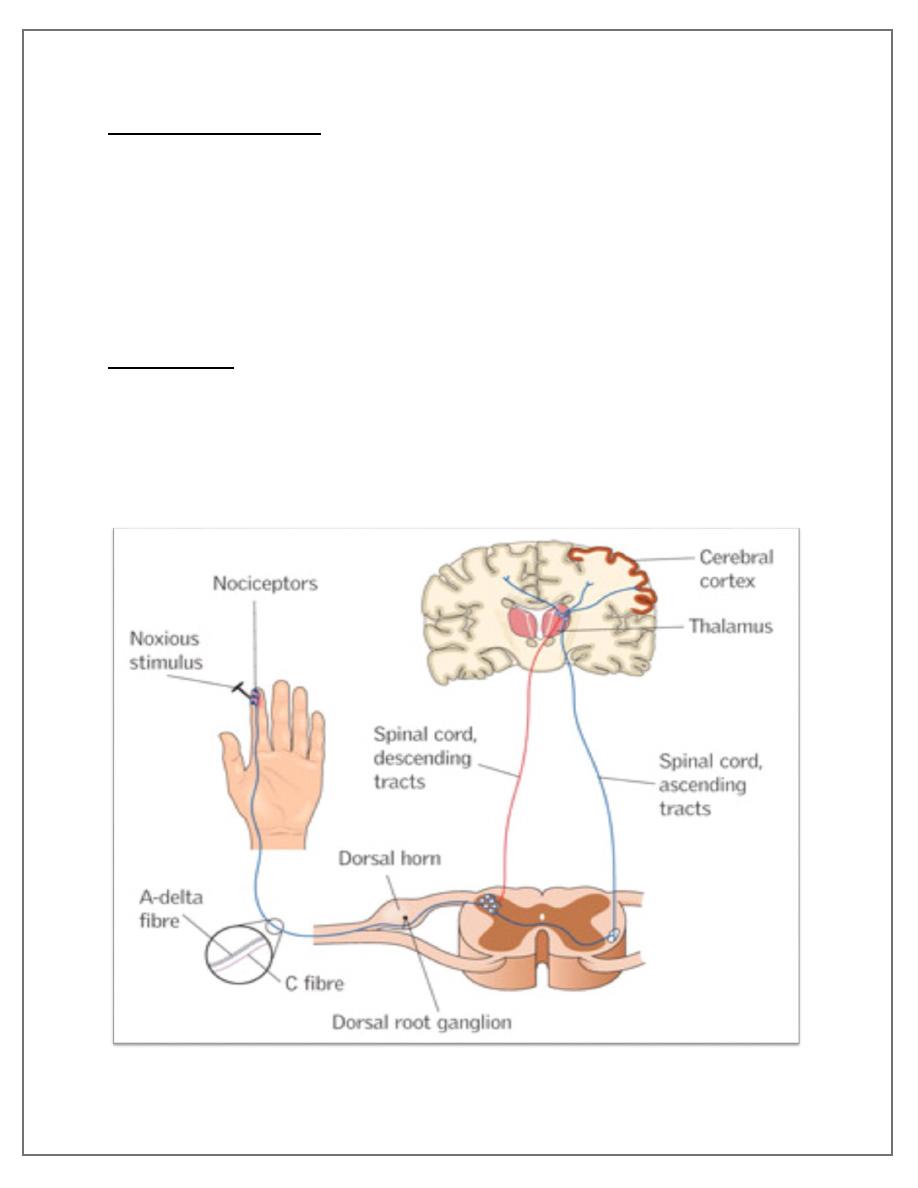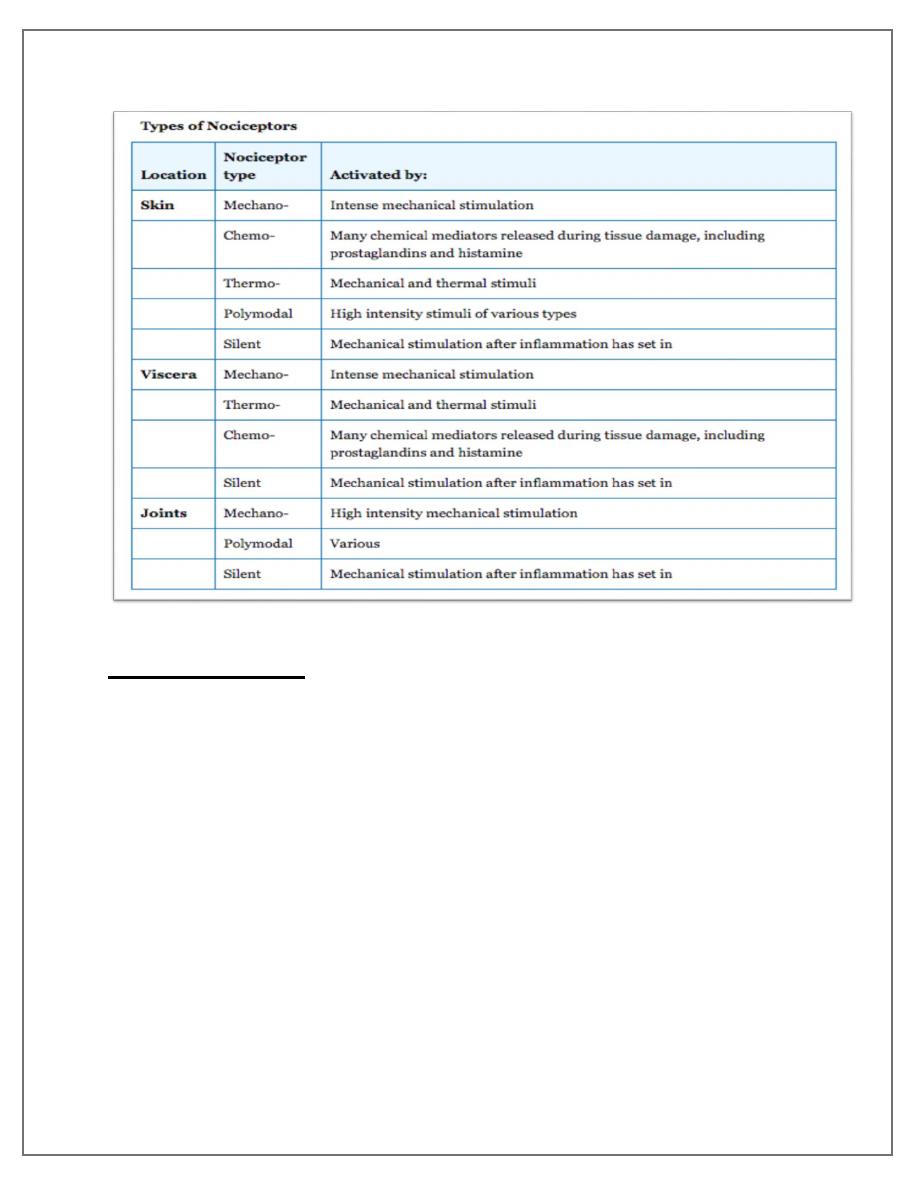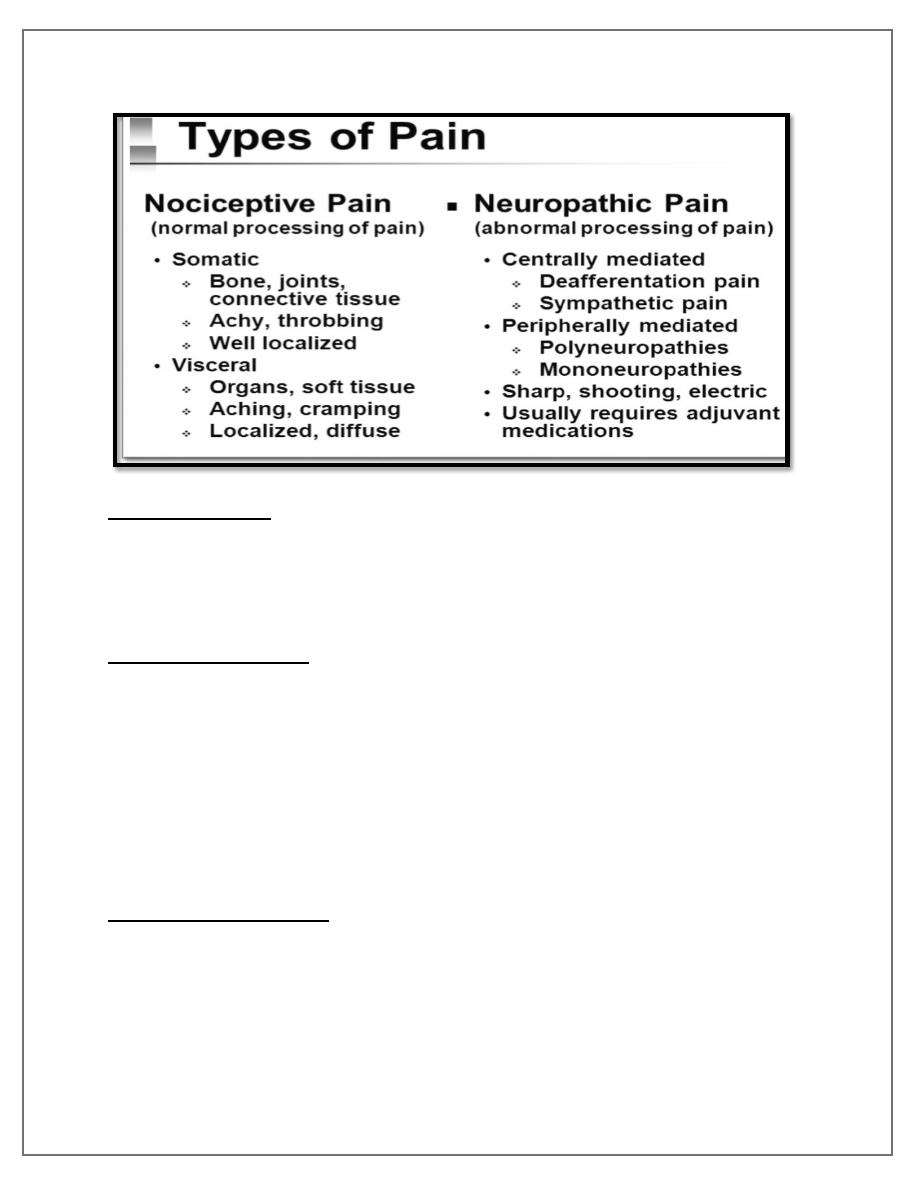
Lec.3 Physiology Dr. Noor Salman
pg. 1
Pain
is an unpleasant sensory and emotional experience associated with actual or
potential tissue damage, or described in terms of such damage. In medical
diagnosis, pain is a symptom, It is a major symptom in many medical conditions,
and can interfere with a person's quality of life and general functioning
.
Physiology of pain
Pain occurs when sensory nerve endings called nociceptors (also referred to as pain
receptors) come into contact with a painful or noxious stimulus.
The resulting nerve impulse travels from the sensory nerve ending to the spinal
cord, where the impulse is rapidly shunted to the brain via nerve tracts in the spinal
cord and brainstem.
The brain processes the pain sensation and quickly responds with a motor
response in an attempt to cease the action causing the pain.

Lec.3 Physiology Dr. Noor Salman
pg. 2
Nociceptive pathway
:
The classic involves three types of neurons:
1.Primary sensory neurons in the peripheral nervous system, which conduct painful
sensations from the periphery to the dorsal root of the spinal cord
2.Secondary sensory neurons in the spinal cord or brainstem, which transmit the
painful sensation to the thalamus
3.Tertiary sensory neurons which transmit the painful sensation from the thalamus
to the somatosensory areas of the cerebral cortex.
Nerve fibers
There are two major classes of nerve fibers associated with the transmission of
pain:
1-Unmyelinated C fibers
2-Myelinated A-delta fibers

Lec.3 Physiology Dr. Noor Salman
pg. 3
Classification of pain
(1) nociceptive pain,
(2) inflammatory pain which is associated with tissue damage and the infiltration
of immune cells,
(3) pathological pain which is a disease state caused by damage to the nervous
system or by its abnormal function (e.g. irritable bowel syndrome, tension type
headache, etc.).
Duration of pain
1- Pain that lasts a long time is called chronic or persistent, Chronic pain may be
classified as cancer pain or else as benign.
2-pain that resolves quickly is called acute, is "pain that extends beyond the
expected period of healing".
1.Nociceptive pain
Caused by stimulation of peripheral nerve fibers that respond only to stimuli
approaching or exceeding harmful intensity (nociceptors), and may be classified
according to the mode of noxious stimulation.
1.Thermal the most common categories are (e.g. heat or cold),
2.Mechanical (e.g. crushing, tearing, shearing, etc.)
3. Chemical (e.g. chemicals released during inflammation).
Nociceptive pain may also be divided into:
"visceral", "deep somatic" and "superficial somatic" pain

Lec.3 Physiology Dr. Noor Salman
pg. 4
2.Neuropathic pain
is caused by damage or disease affecting any part of
the nervous system involved in bodily feelings (the somatosensory system).
Peripheral neuropathic pain is often described as "burning", "tingling", "electrical",
"stabbing", or "pins and needles".
Neuropathic pain can be associated with diabetic neuropathy, radiculopathy, post
herpetic neuralgia, phantom limb pain, tumor-related nerve compression, neuroma,
or spinal nerve compression.

Lec.3 Physiology Dr. Noor Salman
pg. 5
3.Phantom pain
Is pain felt in a part of the body that has been lost or from
which the brain no longer receives signals.
It is a type of neuropathic pain.
Phantom limb pain is a common experience of amputees
.
4. Psychogenic pain
is defined as pain that persists despite the lack of any
identified underlying physical cause.
is pain caused, increased, or prolonged by mental, emotional, or behavioral factors.
Headache,
back pain,
and stomach pain
are sometimes diagnosed as psychogenic.
5. Breakthrough pain
is transitory acute pain that comes on suddenly and is
not alleviated by the patient's normal pain management.
It is common in cancer patients who often have background pain that is generally
well-controlled by medications.

Lec.3 Physiology Dr. Noor Salman
pg. 6
6.Incident pain
is pain that arises as a result of activity, such as movement of
an arthritic joint, stretching a wound,
Thresholds
In pain science, thresholds are measured by gradually increasing the
intensity of a stimulus such as electric current or heat applied to the body.
• The pain perception threshold is the point at which the stimulus begins to
hurt, and
• The pain tolerance threshold is reached when the subject acts to stop the
pain.
Mechanisms of Pain
Pain can be caused by a mechanical, chemical or inflammatory, or thermal
mechanism.
Pain of mechanical origin can be caused by acute trauma, injury, or overuse.
It may be constant, variable, or intermittent in nature and is affected by movement
and position.
Pain of chemical or inflammatory origin is associated with arthritis and other
inflammatory disorders.
It is often constant but responds to positioning, therapy, rest, and gentle movement.
Medications are usually a part of the management regimen for chemical or
inflammatory pain.
Pain of thermal origin is the result of excessive heat or cold.
If an acute pain sensation is intense enough, it can cause system-wide responses:
increased alertness; focused attention; the suppression of feeding, sleep, and
reproduction; and increased vascular tone, respiration, and blood sugar levels.
If pain persists or becomes chronic it can even change the circuitry in the central
nervous system.

Lec.3 Physiology Dr. Noor Salman
pg. 7
Pain Sensation
is more complex than previously thought and involves diverse regions of the brain.
Imaging techniques have allowed us to understand that pain results from activation
of a number of brain regions such as the amygdala, insula, or the anterior cingulate
cortex.
We are learning that pain is a result of complex interactions between the immune,
nervous (both CNS and autonomic nervous system), and endocrine systems
Sensitization
is a neurophysiologic term that describes the increased
responsiveness of nociceptive neurons (the pain pathways become more
sensitive).This can include a drop in the threshold for activating nociceptors and an
increase in the frequency of firing for all stimuli.
In sensitization, stimuli that would not normally cause pain, such as the light touch
of a sheet on the skin, can cause intense pain.
